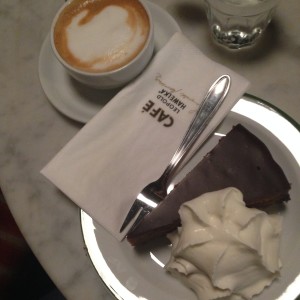fter spending five months on the other side of the world eating totally different cuisine, another food post was inevitable. This one is a bit different from my last one, however, in that I didn’t actually make the food myself. The items featured in this post are just a few of the Austrian foods that I have sampled through out my stay. I found most of these listed on almost every menu in Leoben, which is how I knew they were some of the more traditional foods in the country. Leoben isn’t a very big town, and with only one big restaurant in the main square, if you see an item in more than one place, you take notice.
I’m going to start with one of the most stereotypical Austrian foods just to knock it off the list: Wiener Schnitzel. The closest thing I can compare this to in the U.S. is an Austrian chicken fried steak. The locals would probably be horrified to hear me say it, but it’s all I could think of whenever I tried it. I must admit I did not enjoy it quite as much as most others there, or as much as I had hoped I would. Many of my friends in town kept asking us if we were tired of Schnitzel yet, but when I spent most of my meals in my own kitchen, I really didn’t get much of an opportunity to eat it. Out of the few times I did have it, my favorite by far was after a long day of skiing. A nice slab of Schnitzel with lemon and cranberry sauce is pretty hard to beat when you are exhausted from a day on the slopes.
This next food may sound familiar as I did write about it in one of my previous blogs:�Goulash. The versions I tried in the restaurants tasted a bit different from our homemade version, however. I don’t know what it was, maybe just the fact that each restaurant had perfected its own special version of the traditional soup, but it seemed as though every time I ordered it, it tasted slightly different and slightly better. Even though I was a bit hesitant to try it (possibly too many movies/books growing up with children referring to it in a negative light), a nice, large bowl of thick goulash is always a perfect lunch on a cold winter day.
Another soup that was beloved by many fellow students was Frittatensuppe. During my first week of school, some other petroleum students took me to a local restaurant and told me I simply had to try it. When I asked what it was, they could only explain it as ‘pancake soup.’ I must have looked a bit worried at that description because they hurriedly assured me that it was, in fact, delicious. The soup consisted of little pancake-like strips of dough in a very thin broth. It was a bit to doughy for my liking, unfortunately. For any sweet tooths out there, however, this may be right up your alley.
The Austrians certainly like their bread and meat. From what I could tell, second to the Schnitzel is the boiled beef known as Tafelspitz. Growing up in Texas with all the spicy you can handle at your fingertips, this particular meal was a bit bland for me. This thin slice of meat is boiled in a thin broth with vegetables (most commonly potatoes, turnips, spinach, carrots, etc.). The soup not only gives a bit of flavor to the meat, but also serves as the first course to the meal! A favorite side dish to accompany the meat is the dumpling-like�Kn�del. This doughy ball reminded me of my parents� thanksgiving stuffing rolled up into a bread-roll-sized ball. It also pairs perfectly the Tafelspitz.
In addition to these more local, year-round, main-course dishes, I was also able to try a few special beverages as well. One particular winter drink I had never heard of, but is apparently a favorite of people throughout Austria and Germany. Some of the other exchange students I met in my first few weeks in Leoben told me I had to try the warm Gl�hvein before it went out of season. This sweet, warm, red wine is served mainly at Christmas markets and events, but many restaurants serve it throughout the winter because their customers love it so much, lucky for me as well, because I would not have had the opportunity to try it had they discontinued it with the end of the holidays! While delicious, the drink was much thicker and sweeter than I expected, and I don’t think I would be able to drink it year-round; but having a glass with friends in one of the local restaurants with snow on the ground outside was always a good way to spend a relaxing night.

Wiener Melange and Sacher Torte at a traditional coffee house in Vienna.
I also had the opportunity to visit Vienna’s famous coffee houses to order a Wiener Melange and a slice of Sacher Torte to accompany it. The Weiner Melange is essentially a ‘specialty cappuccino’ made properly only in Vienna. After drinking an innumerable amount of cappuccinos in Leoben, I can say I tasted a slight difference, though I was not expecting it! The Sacher Torte is a specialty dessert that Austria claims. It is a type of chocolate cake that it rich, and creamy, and delicious. While I have ordered it in a few restaurants here in the states as well, none can compare to one shared in one of Vienna’s beautiful coffee houses.
Hopefully if any of you end up in Austria you now have an idea of what food to expect and what you may (or may not) want to order!
Alex



